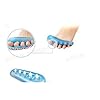 A bunion is a bony prominence on the side of the foot, at the base of the big toe joint. This enlargement of the joint, spurring, bump or lump can be aggravated by sports and tight shoes. There is progressive movement of the big toe outward, toward the other toes. As the ?bump? gets bigger, shoes can increase pressure on the base of the big toe causing more and more discomfort or pain. The term Hallux Valgus is the medical name for this condition.
A bunion is a bony prominence on the side of the foot, at the base of the big toe joint. This enlargement of the joint, spurring, bump or lump can be aggravated by sports and tight shoes. There is progressive movement of the big toe outward, toward the other toes. As the ?bump? gets bigger, shoes can increase pressure on the base of the big toe causing more and more discomfort or pain. The term Hallux Valgus is the medical name for this condition. Causes
Bunions are most often caused by an faulty foot mechanics. It is not the bunion itself that is inherited, but certain foot types that make a person prone to developing a bunion. Although wearing shoes that crowd the toes won't actually cause bunions in the first place, it sometimes makes the deformity get progressively worse. That means you may experience symptoms sooner.
Symptoms
Symptoms include pain in and around the ball of the big toe, usually from the bone rubbing too much against the shoe. You may be unable to wear certain types of shoes due to the shape of the forefoot. The big toe appears to be bent inwards towards and in come cases over the inside toe.
Diagnosis
Before examining your foot, the doctor will ask you about the types of shoes you wear and how often you wear them. He or she also will ask if anyone else in your family has had bunions or if you have had any previous injury to the foot. In most cases, your doctor can diagnose a bunion just by examining your foot. During this exam, you will be asked to move your big toe up and down to see if you can move it as much as you should be able to. The doctor also will look for signs of redness and swelling and ask if the area is painful. Your doctor may want to order X-rays of the foot to check for other causes of pain, to determine whether there is significant arthritis and to see if the bones are aligned properly.
Non Surgical Treatment
Patients should immediately cease using improperly fitted shoes. Footwear selection should have a wide and roomy toebox to accommodate the full width of the foot. If the problem is the over-pronation, the patient should be fitted with orthotics and can expect a slow recovery from pain over a period of months. Orthotics will not cause the physical deformity to regress, but will simply arrest any further progression and likely stop the pain. It is important to note however, that when bunions are severe and require surgery, the bunion can be corrected, but will develop again unless the root cause of over-pronation is corrected. If over-pronation is the root cause, orthotics will still be necessary.

Surgical Treatment
Surgery isn't recommended unless a bunion causes you frequent pain or interferes with your daily activities. If conservative treatment doesn't provide relief from your symptoms, you may need surgery. There are many different types of surgical procedures for bunions, and no particular bunion procedure is best for every problem. If the bunion gets worse and more painful, surgery to realign the toe and remove the bony bump (bunionectomy) can be effective. Most surgical procedures include a bunionectomy, which involves. Removing the swollen tissue from around your big toe joint. Straightening your big toe by removing part of the bone. Realignment of the 1st metatarsal bone to straighten out the abnormal angle in your big toe joint. Permanently joining the bones the 1st metatarsophalangeal joint. It's possible you may be able to walk on your foot immediately after a bunion procedure. However, full recovery can take up to eight weeks or longer with some bunion procedures. To prevent a recurrence, you'll need to wear proper shoes and a foot orthotic after recovery. No surgical procedure is without risk and you may still have pain or you could develop a new bunion in your big toe joint after surgery.